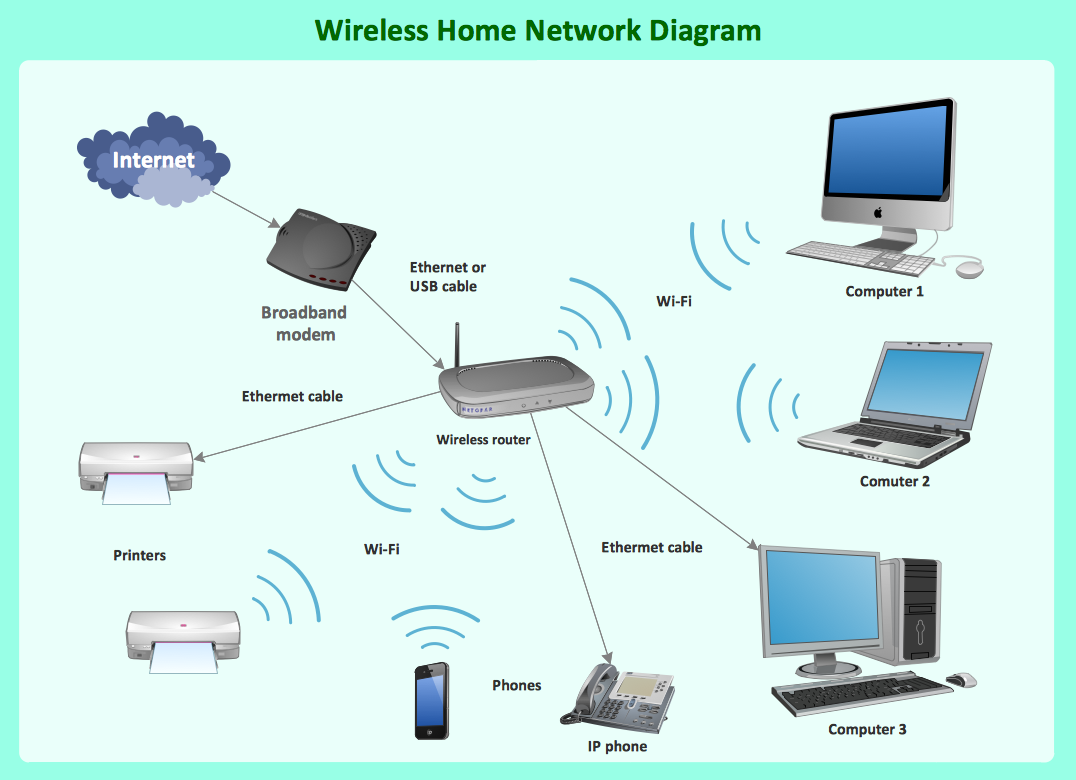The advent of the router stands as a technological marvel that has significantly transformed and streamlined our daily lives. This unassuming device, a cornerstone of modern connectivity, has wrought a revolution in the realm of the internet. Its profound impact has transcended the ordinary, ushering in an era of unparalleled ease and efficiency. In this article, I am going to talk about types of wifi routers.
In the grand tapestry of technological advancement, the router stands tall as an unassuming but indispensable cornerstone. Its evolution from a simple connectivity device to a sophisticated orchestrator of data flow mirrors the rapid pace of our digital age. As we continue to navigate the ever-expanding realms of cyberspace, the router remains steadfast, ensuring that the threads of our connected lives are woven seamlessly, enriching our daily experiences in ways both seen and unseen.
Orchestrating Seamless Internet: The Functionality Unveiled
A router, in its essence, is not merely a gadget; it is the linchpin of optimized internet usage. This unobtrusive device acts as a conductor, orchestrating the symphony of data flow within our digital landscape. It ingeniously manages the traffic of information, ensuring a seamless and swift connection between devices. Its prowess lies in its ability to handle the intricate dance of data packets, transforming the chaotic expanse of cyberspace into a well-choreographed performance.
Diverse Arsenal of Connectivity: Unveiling the Spectrum of Wifi Routers
In our contemporary digital tapestry, the array of Wifi routers available is a testament to the diverse needs and preferences of users. From the unassuming single-band routers catering to basic needs to the sophisticated tri-band routers orchestrating a harmonious interplay of frequencies, the options are as varied as the digital landscapes they serve. These routers, akin to technological maestros, cater to the intricacies of our connectivity requirements, providing tailored solutions for every user.
Navigating the Wireless Seas: Types of Wifi Routers Explored
Delving into the intricacies of Wifi routers reveals a nuanced taxonomy. Single-band routers, operating on the 2.4GHz frequency, navigate the airwaves with a steady hand, providing a reliable connection for routine tasks. Dual-band routers introduce a layer of complexity, employing both 2.4GHz and 5GHz bands to navigate the congested airspace, ensuring a more robust and interference-resistant connection. The zenith of this technological hierarchy is reached with tri-band routers, a triumvirate of frequencies, seamlessly distributing the load and optimizing performance for the most demanding of digital endeavors.
A Tapestry of Connectivity: The Impact on Daily Life
In the warp and weft of our daily existence, the router emerges as an unsung hero, weaving the fabric of our connected lives. From the mundane to the extraordinary, its impact is omnipresent. Whether facilitating a casual browsing session or supporting the demands of bandwidth-intensive activities like online gaming and high-definition streaming, the router is the silent architect of our digital experiences.
What is a WiFi Router?
A WiFi router, far from being a mere conduit, emerges as a technological virtuoso orchestrating a complex ballet of data transformation and wireless connectivity. Its significance transcends the mundane, shaping the way we interact with the digital realm, making it a cornerstone in the edifice of modern connectivity.
Understanding the Essence of a WiFi Router
At its core, a WiFi router serves as a pivotal digital device in the realm of modern connectivity. In the simplest terms, its primary function revolves around the transmission of information garnered from an Internet cable to a multitude of diverse devices. However, delving deeper into its multifaceted nature reveals a more intricate tapestry of operations. Not confined to mere data conveyance, a WiFi router assumes the role of a wireless access point, utilizing the medium of radio signals to disseminate information. The subtlety lies in the various types of routers, each tailored to specific needs and nuances, thereby adding an extra layer of complexity to the technological landscape.
The Dynamic Facets of a WiFi Router
A WiFi router, in its dynamic functionality, transcends the conventional boundaries of a mere conduit for Internet data. Beyond the elementary task of relaying information, it metamorphoses the data stream emanating from your Internet connection into a sophisticated array of radio signals. This metamorphosis is particularly manifested in the diverse spectrum of wireless routers available in the market. Whether it be the prowess of dual-band routers or the advanced features of tri-band routers, each variant imparts a distinctive character to the wireless communication ecosystem. The router, in this sense, emerges as a sophisticated orchestrator, harmonizing the intricate dance of information in a wireless symphony.
Wireless Alchemy: Transforming Data into Radio Signals
The alchemy transpiring within a WiFi router is nothing short of technological wizardry. At its core, this electronic maestro transfigures the raw data coursing through the Internet cable into ethereal radio signals. Picture this transformation as the conversion of mundane bits and bytes into a dance of electromagnetic waves, poised to traverse the digital airspace. This metamorphosis is not merely an act of transmission but an intricate ballet wherein data assumes a wireless form, ready to pirouette through the airwaves. It’s a fusion of the tangible and the intangible, where information takes flight, transcending the physical confines of cables.
Reception Ballet: WiFi-Enabled Devices in the Limelight
The culmination of this technological ballet unfolds with the reception of these wireless signals by an ensemble cast of WiFi-enabled devices. Smartphones, laptops, tablets—each assumes the role of a receptive dancer in this grand performance. The WiFi signals, once liberated from the shackles of cables, find a new purpose as they elegantly swirl around these devices. The seamless integration of WiFi technology with these gadgets marks the zenith of the router’s influence. It transforms these devices into portals of connectivity, allowing them to tap into the digital symphony orchestrated by the router. The diversity of the devices adds a vibrant dimension to this connectivity, creating a harmonious ensemble of technology in motion.
Types of WIFI Routers
There are three varieties of routers available in the market. These types of WIFI routers are the main categories.
3. Other Types of Routers
These routers orchestrate a symphony of connectivity, ensuring that the pulse of communication beats harmoniously, whether through the tangible threads of wired connections or the ethereal waves of wireless signals. As we navigate this interconnected era, these routers stand as silent sentinels, steadfastly anchoring our digital connectivity with their intricate web of routing and filtering capabilities.
IV. Core Routers
At the heart of any Local Area Network (LAN) or Wide Area Network (WAN) lies the indispensable presence of core routers, strategically positioned within the network’s central nexus rather than lingering on its periphery. These technological linchpins serve a pivotal role in interconnecting distribution routers across diverse structures within a campus or LAN, as well as in the broader scope of a Large Enterprise Location. Picture them as the architectural backbone, orchestrating the symphony of data flow within the network infrastructure.
In specific scenarios, core routers assume the responsibility of establishing a step-down spine, intricately weaving together the distribution routers that span multiple buildings within a campus or LAN. These routers are not mere conduits; rather, they are meticulously optimized for the seamless transmission of data at remarkably high bandwidths. Their placement at the core signifies a strategic design choice, emphasizing their centrality to the network’s robust functioning.

V. Wired and Wireless Routers
The contemporary landscape of home and small office networking is witnessing an escalating reliance on IP wired and wireless routers, transforming the way we connect and communicate daily. These routers, both wired and wireless, operate as veritable custodians of routing and configuration information, meticulously cataloged within their routing tables. This repository of data forms the neural network, governing the efficient flow of information through the intricate channels of the router’s architecture.
Functioning as more than mere conduits, these routers also serve as vigilant gatekeepers, offering the indispensable service of filtering the ebb and flow of traffic—both incoming and outgoing—based on distinctive IP addresses. In essence, they act as sentinels, discerning and regulating the passage of packets, ensuring that the network’s pathways remain secure and well-ordered. This dual capability, seamlessly blending routing prowess with traffic management, underscores the multifaceted role that these routers play in our interconnected digital age. How AI, ChatGPT maximizes earnings of many people in minutes
Each router, whether tethered by cables or harnessing the freedom of wireless connectivity, embodies a sophisticated amalgamation of technology and intelligence. These devices are not just instruments of connection; they are the architects of digital dialogues, navigating the complexities of routing protocols while safeguarding the network’s integrity through meticulous traffic filtration.
How to Choose a WiFi Router?
More Interesting Articles
- 10 Great Michael Faraday Inventions and Discoveries
- 17th-Century Medical Inventions and Achievements
- Invention of 150 Antibiotics – TimeLine | Facts | History
- Invention of Vaccines – TimeLine | History | Inventors
- 300 Medical Inventions and Discoveries – Antiquity to Modern
- 20 Greatest Medical Technology Inventions of All times
- 44 Electrical Safety Symbols Signs – Meaning to Know
- 10 Electrical Hazards and Safety Measures – Home | Workplace
- 50 Electrical Safety Tips for Home | Appliances | Workplace | Industries
- 20 Great Electrical Engineering Inventions of All-Times
- Simple History of the Internet Timeline 1957-2021
- 8 Wonders of the Ancient World One Must Visit
- List of 215 Nobel Prize Winners in Physics – 1901-2020
- 10 Ancient Egypt Technology and Inventions
- 40 Smart Innovations of the 1920s Still In Use
- List of Eponymously Named Medical Signs and Conditions
- Scientific Phenomena Named after People in Everyday Life
- 35 Remarkable Ancient Indian Inventions and Technologies
- List of Constants in Science Named After People
- 15 Top Mayan Achievements and Inventions
